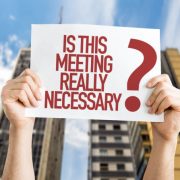8 Tips To Prevent An Ineffective Meeting!
Do you constantly find your mind wandering off during meetings and walking out at the end feeling that it was a waste of time? Well — join the club as up to 50% of meetings are considered to be ineffective. Meetings that are deemed to contribute little or no value are often characterised by poor preparation, unclear agenda, no concrete decisions made, domination by a few individuals, off-topic conversations and lack of follow up. Along with a loss of treasured time, ineffective meetings cost money! Harvard Business Review developed a great and simple tool to calculate how much a meeting costs a company. It looks at how long the meeting is, how many attendees are present, and the estimated salary of each person attending. Once all those details are entered, it calculates how much that meeting actually costs the company. This is why it is key to ensure maximum value is derived in all meetings — to this end, here are 8 tips to consider.
- Is a meeting the best solution? Not every task has to be addressed in the form of a meeting, consider if your objective can be achieved via email, a phone call or quick individual discussion with the relevant people? Alternatively, it may be of more value to use that block of time in your calendar to attend to the task in another manner.
- Agenda! Agenda! Agenda! A well-defined agenda sent out in advance is half the success of a meeting. In the agenda, include the length, the topics to be discussed and any actions you want to pre-allocate to attendees. E.g. next to a line item like “Finalise workshop location” you can take it a step further and say “Thomas, please prepare a high level comparison of the 3 venue options”. Try to avoid more than 5 agenda items in order to ensure adequate time is spent on each item and the list is not too long, as this can make the meeting rushed or end without covering everything.
- Less (people) is more. Interrogate the necessary presence of everyone you invite. Best practice is to limit attendees and preferably have no more than approximately 6 people to avoid unnecessary spectators.
- Start on time. Create a culture of starting on time and being ruthless to late comers. Some companies even lock the doors after the meeting starts (this may prove a bit of a challenge if the meeting owner is part of the late bunch).

- Keep it short. Between 30-60 minutes is ideal for meetings and preferably not more than that. Do not be afraid to end a meeting early if you actually finish before time – there is no need to unnecessarily stretch things in order to make use of the left over time.
- Avoid off-topic conversations. Stay on track and avoid going off a tangent. If an off-topic conversation is deemed important, have a “parking lot” to list off topic items. This keeps the meeting focused yet acknowledges important points raised by attendees to be attended to offline or in another meeting.
- Prioritise decision making. Try and prioritise meeting time for decision-making. This works well if pre-work is sent out and attendees are expected to turn up prepared. If you are having the meeting solely to share information, consider whether the information can be shared in another way. Information-gathering should always be performed prior to meetings
- Define next steps. Re-iterate the next steps and any follow up actions to close off each meeting.
Assess your next meeting against this checklist of 8 points and benchmark how effective your meetings are. It is also of value to review, in particular, your recurring meetings every quarter or bi-annually to see if their format and purpose is still serving its purpose – and re-evaluate if necessary.



